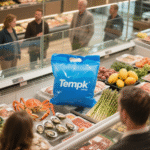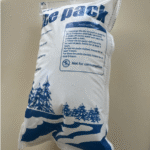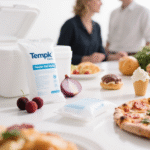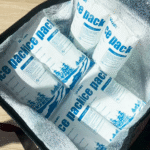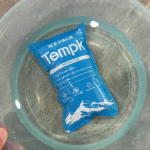Gelo seco: Como você envia direto 2025?
If you ship with dry ice UPS, você deve marcar UN1845, show the net dry ice in kilograms, and use vented packaging under IATA PI 954. UPS also applies a 68 kg (150 Libra) per‑package cap for small‑package air, so plan labels, Texto awb, and packouts to pass acceptance on the first try. These rules keep your team safe and your payload frozen.
-
Passe na aceitação pela primeira vez with a PI 954 Lista de verificação, Marcas UN1845, and AWB wording (UPS PI 954 Lista de verificação).
-
Right‑size refrigerant loads using a simple dry‑ice sizing rule for 24–96 h routes (dry ice UPS sizing).
-
Escolha embalagens compatíveis—vented EPS/VIP shippers; no sealed liners (dry ice UPS packaging).
-
Set up UPS tools to enter dry‑ice weights in kg and avoid common rejection traps.
What exactly does dry ice UPS require in 2025?
Resposta curta: Ventive o pacote, marque “Gelo Seco” / “Dióxido de Carbono, sólido" + “UN1845,” and print the net dry‑ice mass in kilograms on the outer carton; repeat UN1845 + net kg on the Air Waybill. UPS small‑package air overlays a 68 kg per‑package limit even though IATA’s general max is 200 kg when used as a refrigerant for non‑DG.
Por que isso importa: Carriers audit these lines. A missing “net kg,” a sealed liner, or assuming the IATA max applies in UPS small‑package lanes are the fastest paths to rejection. Treat the carton as a “vented mini‑freezer”: gas must escape; labels and AWB must match; and any ground shipment that could be uplifted to air should be built air‑compliant by default.
How to label a dry ice UPS caixa (UN1845) o caminho certo
Put all marks on one side: “UN1845,” the proper name, o NET KG, remetente/consignatário, mais o Aula 9 diamante. On the AWB’s Nature & Quantity of Goods linha, enter UN1845, the proper name, contagem de pacotes, e NET KG. Mantenha a embalagem ventilado; never heat‑seal an inner bag around dry ice.
| What you’re doing | Aqui está Pi 954 | UPS Small‑Package Air | O que isso significa para você |
|---|---|---|---|
| Per‑package dry‑ice limit | Até 200 kg | 68 kg máx | Split loads or use a different service if above 68 kg. |
| Ventilação | Obrigatório | Obrigatório | No sealed liners; maintain a CO₂ escape path. |
| Marks on carton | UN1845 + Nome adequado + NET KG | Mesmo | Usar quilogramas on the box and AWB. |
| Declaração | Not required for non‑DG contents | Mesmo | Use the dry‑ice acceptance checklist only. |
Practical tips to pass acceptance
-
Convert to kg and round down on the label if you track weight in pounds.
-
Don’t write on the Class 9 diamante; keep the label face clean.
-
Print an AWB helper (UN1845 + Nome adequado + NET KG + contagem de pacotes) to avoid missed fields.
Caso do mundo real: A biotech added an auto‑print for “UN1845 — Net X.X kg” and retrained on the 68 kg cap. Acceptance failures dropped near zero and porch‑time buffers cut spoilage ~15% during heat waves.
How much dry ice do you need for dry ice UPS rotas?
Regra geral: Plano 5–10lb por 24h em um remetente bem isolado; comece em 7.5 lb/dia, adicionar +2 lb/dia para EPS fino (<1.5″), subtrair −1 lb/day para vips, e adicione +2 lb/dia for hot lanes or long doorstep dwell. Each pound vents ≈ 8.3 ft³ of CO₂, so ventilate packout rooms and vehicles.
Make it yours: Pre‑freeze the payload and the shipper, Minimize o espaço da cabeça, cradle the blocks to reduce abrasion, and design a clear vent path. Piloto 3 boxes on your longest lane, log temps and residual mass, then tune the load by 10–20% for seasonality.
Calculadora de copiar e colar (Excel/Sheets)
-
InsulationAdj:
+2if EPS <1.5″;−1if VIP -
AmbientAdj:
+2pistas quentes / long porch dwell -
TransitDays: include 0.5–1 day buffer
| Escolha de isolamento | Parede típica | What you get | O que assistir |
|---|---|---|---|
| EPS | 1.5–2,0″ | Affordable baseline for dry ice UPS | Larger outer box; Mais gelo seco |
| Pur | ~1.5″ | Smaller carton at same performance | Odor/compatibility checks |
| Painéis VIP | 0.5–1,0″ | Longest holds, smallest carton | Custo mais alto; careful handling |
Actionable scenarios
-
48–72 h meal kits: Comece próximo 7.5–10lb/dia; adicionar +1 dia buffer in summer.
-
96 h lab route: Use VIP to cut load by ~1 lb/day; double‑box for abuse lanes.
-
Alimentos congelados a granel: Split packages to stay ≤ 68 kg para o ar; migrate heavy loads to ground where economical.
Caso real: A frozen D2C brand right‑sized from the “max ice” habit to the rule above and reduced cost while holding temps across 72 h lanes.
Dry ice UPS for ground vs. AIR vs.. international—what changes?
Chão (NÓS.): When used only as a refrigerant for non‑hazardous contents, dry ice is generally not regulated as hazmat; still mark UN1845 e continue com a embalagem ventilada. Ar: Seguir Pi 954 and UPS’s 68 kg cap for small‑package air; include UN1845 details on the AWB. Internacional: Same PI 954 essencial; check UPS operator variations and accepted countries, plus ISC participation where relevant.
Do you need a contract or ISC for dry ice UPS?
For domestic non‑DG contents, no DG Shipper’s Declaration is required—use the PI 954 acceptance checklist and proper AWB text. Some international lanes or commodities may require ISC participation; verify per lane before pickup. Configure WorldShip/DG tools to select Dry Ice (UN1845) and enter kg for net mass.
2025 dry ice UPS desenvolvimentos e tendências
O que há de novo: IATA refreshed its 2025 Lista de verificação de aceitação (Pi 954 essentials: UN1845 on the AWB, embalagem ventilada, no LQ), and UPS’s International Chemical Table (eficaz 01/01/2025) continues the 68 kg operator maximum for small‑package air. Expect tighter audits of AWB wording and net‑kg markings at acceptance.
Último progresso em um olhar
-
Standardized acceptance checks: AWB and on‑carton net‑kg fields are scrutinized.
-
Carrier variations matter: Plan early splits to live under the 68 kg cap.
-
Healthcare growth: UPS continues to add temp‑controlled capacity; dry‑ice demand swings seasonally.
Insight de mercado: For many U.S. expedidores, chão is a cost‑effective fallback because dry ice used only as a refrigerant is often outside hazmat scope on highway—build air‑compliant labels by default so routing flips don’t cause rework.
Perguntas frequentes
Q1: What is the maximum dry ice UPS allows per package by air?
UPS small‑package air shows 68 kg (150 Libra) por pacote, even though IATA’s general maximum is 200 kg when used as a refrigerant for non‑DG.
Q2: Do I need a Shipper’s Declaration when dry ice cools non‑DG contents?
Geralmente não. Label the carton and include UN1845 details (nome, contagem de pacotes, NET KG) na AWB; packaging must vent under Pi 954.
Q3: Can I seal a plastic bag around dry ice for cleanliness?
Não. The package deve liberar CO₂. Sealed liners risk rupture and rejection at acceptance.
Q4: How much CO₂ gas does a pound of dry ice release?
Sobre 8.3 ft³ per pound—ventilate packout rooms and vehicles; monitor exposure against 5,000 ppm (Twa) e 30,000 ppm (DEFINIR) diretrizes.
Q5: Where do I enter dry‑ice details in UPS tools?
In WorldShip/DG workflows, selecione Gelo Seco (UN1845) and enter the weight in kg so labels and AWB match acceptance checks.
Resumo & Recomendações
Pontos -chave: To ship with dry ice UPS, embalagem de ventilação, imprimir UN1845 + NET KG, seguir Pi 954 para o ar, and respect UPS’s 68 kg small‑package cap. Use rigid insulation, Minimize o espaço da cabeça, e tamanho 5–10lb/24h, then validate with a 3‑box pilot. Ventilate work areas to keep CO₂ within safe exposure limits.
PRÓXIMOS PASSOS:
-
Pick your service (solo vs.. ar); verify lane acceptance/ISC for international.
-
Design the packout: choose EPS/VIP, compute load with the calculator above.
-
Rótulo & documento: UN1845 + Nome adequado + NET KG; Aplicar aula 9 on the same side; mirror details on the AWB.
-
Configure UPS tools e equipes de trem on the 68 kg cap and venting. Fale com a Temk for a lane‑by‑lane SOP and label set.
Sobre Tempk
Nós projetamos carrier‑ready cold‑chain packouts that pass acceptance on the first try. Our engineers tune insulation and refrigerant loads for dry ice UPS pistas, automate UN1845/kg líquido rótulos, and build SOPs your team can run in days—cutting rejections and spoilage on your busiest routes.
CTA: Request a free lane review—get a printable dry ice UPS Sop, a validated sizing plan, and ready‑to‑use label templates.

















